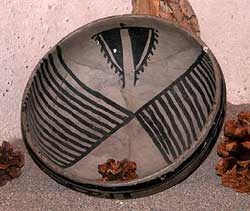Tsankawi | Tsankawi Cave Dwellings | Tsankawi Petroglyphs
 |
| Frijoles Canyon Pottery |
Bandelier's Ancestral Inhabitants
The Pueblo people have lived in the American Southwest for many centuries. Archeologists think they are descended from nomadic hunting and gathering people who came into the region 10,000 to 12,000 years ago. The Pueblo culture originated in the Four Corners Area (where New Mexico, Arizona, Utah, and Colorado meet), but it was not uniform from group to group. Cultural differences, over time and from place to place, are reflected in such surviving remnants as architecture and pottery. Early archeologists, studying the old dwellings for clues to their former inhabitants, adopted the Navajo term "Anasazi" to refer to the ancestors of Pueblo people before the coming of the Spanish.The ancient people of the Bandelier area, like Puebloan ancestors elsewhere, were farmers, who grew maize (corn), beans, and squash. They supplemented their diets with native plants and by hunting and trapping deer, rabbits, squirrels, other mammals, and birds. They made clothing from animal skins and traded for cotton, which they wove into garments. They ingeniously made winter blankets from fibers of the yucca plant interwoven with turkey feathers or strips of rabbit skin. Tools, including a wide variety of axes, mauls, and knives, were fashioned from animal bones, wood, and such local stone as obsidian and basalt. The people obtained other items, such as shell, turquoise, and parrots, through trade networks that ranged as far as central Mexico and Baja California.
The Puebloan ancestors occupied the Bandelier area for nearly 500 years. With less than half the monument surveyed, more than 2,400 sites have been located, but not all sites were inhabited at the same time.
For generations the people lived in small, scattered settlements, each consisting of perhaps only one or two families. Then from about A.D. 1150 to 11325, sometimes called the Rio Grand Coalition Period, the population increased. People began coming together in larger groups and by the end of the period, villages (pueblos) often included as many as 40 rooms.
The following two and a half centuries, called the Rio Grand Classic Period, were characterized by fewer and larger pueblos, some exceeding 600 rooms, and by the prevalence of very small structures that archeologists call field houses and believe show seasonal dispersal to agricultural fields. Ceremonial rooms called "kivas" were up to three times larger in classic times and may reflect a changing role in ritual or social life. The pueblo of Tyuonyi and its adjacent cave dwellings in Bandelier are examples from the Rio Grande Classic Period, which ended in the late 1500s when the Spanish colonized New Mexico, bringing immense change to the American Southwest.
The modern Pueblo people have oral traditions that link them to the past, but no written record existed before the coming of the Spanish. Archeologists trying to decipher the relationships of modern pueblo villages to various early sites are often puzzled. Differences in pottery suggest that the people who lived in the part of Bandelier called "Tsankawi" were different from the people who lived in the rest of the monument. Today, the Puebloans immediately to the north and east of Bandelier speak Tewa while those to the south speak Keres. What was the relationship between the people of these language groups in ancestral times? The dwellings in Bandelier may hold the answer.